John D. Meyer, Old Mechanical Penny Banks, 1952 Handbook, Banks 1-15
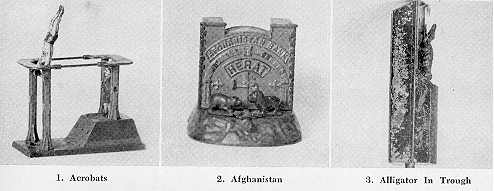
No. 1. Acrobats — Two, who perform on two horizontal bars. Sometimes called the "Gymnast" Bank. Press the lever and the gymnast swings on the bar and kicks the clown causing him to hang by his toes on the opposite horizontal bar, while the performer himself stands upright on his hands. 275068, April 3, 1883. $150.00 ($40.00 in 1939)
No. 2. Afghanistan — A small lion and bear guarding the city gate. Name "Afghanistan" bank in the arch above the gate and word "Heart" across the gates. Very small bank, about 3-1/2 inches high and 3 inches wide. When lever is pressed the small animals move in towards the gate as if to guard it and by their roaring were supposed to arouse the inhabitants within. $200.00 ($35.00 in 1939)
No. 3. Alligator in Tin Trough — This bank is 15 inches long, 2 inches wide, made of tin painted old fashioned red. To operate you blow into the extended end of the bank and the Alligator comes out of hiding and runs along the track with mouth open and grabs the coin and then you suck in and the Alligator goes back into hiding. Elaborate pictures of Alligators in gilt adorn the bank. Word Alligator on each side. On the bottom is this reading: Patented Nov. 5, 1867 through the Patent agency of T. H. Alexander, Washington, D.C." I don’t know how much this bank cost originally but I do know that the price now is awful. $xxxxxx
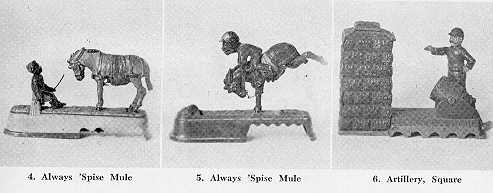
No. 4. Always Did ’Spise A Mule — Darky sitting on a bench in front of the mule. When the spring is released the mule turns completely around and kicks the darky over the bench backwards and coin falls into base under the bench. "Always Did ’Spise A Mule" on base. Stevens catalogue calls this "The Kicking Mule Bank." Stevens, April 22, 1879. $25.00
No. 5 Always Did ’Spise A Mule — Darky riding a mule. Coin is placed in darky’s mouth who deposits it in the base when the mule kicks up his heels and throws the darky over his head. "I Always Did ’Spise A Mule" on base. Also called "Kicking Mule" bank. Stevens, April 22, 1879. 214615. $22.00 ($5.00 in 1939)
No. 6. Artillery — Square Block House — A Soldier standing beside a mortar which shoots coin into a square, or four-sided, block house. When lever is pressed soldier drops his arm as a signal and the shot is fired. "Artillery Bank" on base. Made in bronze finish and also in painted colors. A variety of this bank is the "Mortar Bank" and this name is on the base, otherwise exactly like the Artillery. Recently three Artillery banks have turned up at widely separated places with the soldier wearing a helmet instead of a cap. In checking up I am led to believe these banks were actually made in the foundry and sold. March 20, 1877. 188635. $25.00
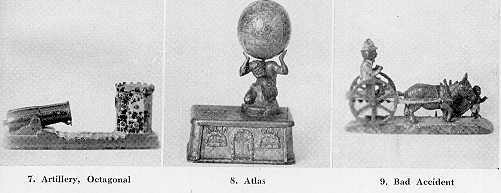
No. 7. Artillery — Eight-Sided Block House — Base is eleven inches long, three inches wide. Entirely different from the four-sided Artillery. The mounted cannon is 4-3/4 inches long. A catch under the cannon is pressed back and coin inserted, then released and coin is shot into block-house. There is no soldier on this bank. November 20, 1877. 197250. $300.00
No. 8. Atlas — Atlas atop a building is carrying the world, or globe on his shoulders. When the coin is inserted and the lever pressed the world spins around. "Atlas Bank" on the front and "Money Moves The World" on top of the base. $120.00
No. 9 Bad Accident — A small negro boy darts out from behind a bush when a lever is pressed, scares the mule, which rears up and upsets the cart and driver. The coin is placed under the seat of the colored driver and falls into the body of the cart. "Bad Accident" on base. Stevens. Varieties. $50.00
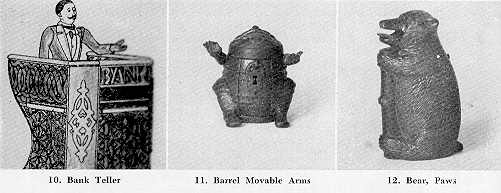
No. 10. Bank Teller — Man standing back of a counter with left hand outstretched. Place coin in hand and the weight of the coin causes it to drop in receptacle. The counter or case is made up of elaborate lattice work with word "Bank" on front. The teller nods his head in thanks as he drops the coin in. The man in this bank is same as in the Preacher in Pulpit. August 1, 1870. $xxxxxx
No. 11. Barrel With Arms — When coin is pushed into the mouth of the upturned face the outstretched arms move and the penny is swallowed. The top of barrel is moon face. Small bank. Top is locked to barrel with small unmovable padlock. Also made in a still bank. $60.00
No. 12. Bear Paws Around Tree — Sitting upright on his haunches, paws around tree stump. Place coin on tongue, press lever in his back and coin disappears. Color black. No trap. To remove coins loosen screw which holds bank together. $40.00
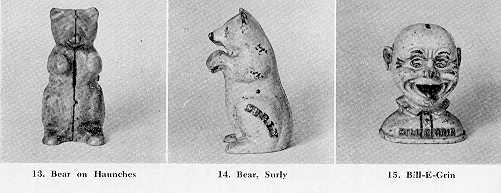
No. 13. Bear, Standing on his hind legs. Slot in breast. Front paws out-stretched. Light yellowish in color. Opens his mouth when coin is inserted in slot in his breast. At one time this bank was considered rather rare but all at once a number appeared on the market and today it is not so rare. $75.00
No. 14. Bear — Surly Bruin. Similar to standing Bear, slot in breast. Words "Surly" on one hip and "Bruin" on other. Same light color. Also place the coin in slot in the breast and he opens his mouth. $85.00
No. 15. Bill E. Grin — Bust. Coin is deposited through a slot in the top of his head, and he turns his eyes and sticks out his tongue. Words "Bill E. Grin" on front, grinning white dour face. Small bank just head and shoulders. Stevens. 1915. $75.00 ($30.00 in 1939)
